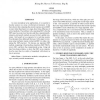Free Online Productivity Tools
i2Speak
i2Symbol
i2OCR
iTex2Img
iWeb2Print
iWeb2Shot
i2Type
iPdf2Split
iPdf2Merge
i2Bopomofo
i2Arabic
i2Style
i2Image
i2PDF
iLatex2Rtf
Sci2ools
ICASSP
2007
IEEE
2007
IEEE
A Real-Time SRP-PHAT Source Location Implementation using Stochastic Region Contraction(SRC) on a Large-Aperture Microphone Arra
In most microphone array applications, it is essential to localize sources in a noisy, reverberant environment. It has been shown that computing the steered response power(SRP) is more robust than faster, two-stage, direct time-difference of arrival methods. The problem with computing SRP is that the SRP space has many local maxima and thus computationallyintensive grid-search methods are used to find a global maximum. Grid search is too expensive for a real-time system. Several papers have addressed this issue. In this paper we propose using stochastic region contraction(SRC) to make computing the SRP practical. We discuss one important SRP method, computing it from the phase transform (SRP-PHAT), review SRC, and show the computational saving. Using real data from human talkers, we show that SRC saves computation by more than two orders of magnitude with almost no loss in accuracy.
ICASSP 2007 | Important Srp Method | Microphone Array Applications | Signal Processing | SRP Space |
| Added | 02 Jun 2010 |
| Updated | 02 Jun 2010 |
| Type | Conference |
| Year | 2007 |
| Where | ICASSP |
| Authors | Hoang Do, Harvey F. Silverman, Ying Yu |
Comments (0)

